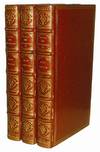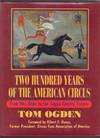![A Natural History of Uncommon Birds, and of Some Other Rare and Undescribed Animals... [With:] Gleanings of Natural History Exhibiting Figures of Quadrupeds, Birds, Insects, Plants, &c..](https://d3525k1ryd2155.cloudfront.net/h/687/435/1595435687.1.m.jpg)
A Natural History of Uncommon Birds, and of Some Other Rare and Undescribed Animals... [With:] Gleanings of Natural History Exhibiting Figures of Quadrupeds, Birds, Insects, Plants, &c..
by EDWARDS, George (1694-1773)
- Used
- Condition
- See description
- Seller
-
New York, New York, United States
Payment Methods Accepted
About This Item
London: Vols. I-V: Printed for the Author, at the College of Physicians, in Warwick-Lane. Vols. VI-VII: Printed by George Sidney, Northumberland Street, Strand, 1806. 7 volumes. 4to. (11 1/4 x 8 3/4 inches). [Uncommon Birds:] 4 parts in 4 volumes. 211 etched plates by and after Edwards, 210 of which finely hand-colored, 1 of "Un Samojeed" uncolored, with dates of initial publication in plates. Bound with engraved general titles in English and French by Johann Sebastian Muller in first volume and letterpress part titles in both languages in all subsequent volumes. The plates and English leaves generally on wove paper, the French leaves generally on laid, with watermarks dating to 1794 on Whatman paper and erroneous dates of publication to 1750. Vol. I frontispiece omitted in this issue. Vol. II with the "Un Samojeed" portrait and catalogs of bird names. Woodcut head and tailpieces and initials. [Gleanings:]: 3 parts in 3 volumes. 152 finely hand-colored etched plates by and after Edwards, numbered 211-362, with dates of initial publication in plates. Letterpress part titles in English and French. All leaves generally wove paper. French and English running double text columns translated by J. Du Plessis and Edmond Barker. Contemporary uniform red full morocco, ruled and elaborately tooled gilt, spines with ten raised bands forming six compartments with gilt bird devices, gilt dentelles, blue marbled endpapers, all edges gilt
Provenance: Bookplate of William Leatham (1785-1842), a prominent English banker, Quaker abolitionist, and father to two members of the British Parliament
A spectacular set of the preferred second edition of "one of the most important of all bird books, both as a fine bird book and a work of ornithology." [Fine Bird Books]
This beautifully colored issue of the superior second edition of Edwards's canonical bird book, bound circa 1806, benefits greatly from being published at a time when two of the book-arts were at their high points: the art of hand-coloring was at its most sophisticated and the design and execution of bindings was equally exceptional. The coloring in this issue has the clear jewel-like quality that is a feature of the work of the best colorists of the Regency period and its uniform red gilt full morocco bindings are stunning. The full history of the publication of Edwards's work has not been fully unraveled. As Lisney writes, "In common with many other publications of the same period many copies of this work were made up from assorted stock, giving rise to considerable difficulty in the identification and collation of ideal copies of the various editions and issues." Watermarks, publication dates, and paper stocks in this example of the 1802-1806 issue date as far back as 1750 and include 1794 and 1800 watermarks, as well as varying laid and wove papers. What is certain is that Edwards's work was hugely successful and went through a number of transformations while under his control, including the issuing of a French text edition. Shortly after Edwards retired in 1769 he sold "to Mr. James Robson, Bookseller all the remaining copies of my Natural History colored under my immediate inspection, together with all my copper-plates, letter-press, and every article in my possession relative to it. And that my labors may be handed down to posterity with integrity, truth, and exactness, I have delivered into his hands a complete set of plates, highly colored by myself, as a standard to those artists who may be employed in coloring them for the future." [Robson] The sequence and form of the rarer later issues, of which the present set is one, is even less well documented than the earlier. Edwards, a contemporary and correspondent of Carl Linnæus, "has been well described as an unscientific but very accurate describer and painter of animal life, and his writings will always remain of paramount authority, from the faithfulness of his description of many new birds, subsequently incorporated in the Linnaean System. He had the simplicity and piety of Izaac Walton, and may be looked upon as one of our greatest worthies." [Mullens and Swann]. The illustrations in Natural History and Gleanings are charmingly off-beat and resonate with a contemporary verve. Edwards undertook his prodigious color-plate project after he was chosen Librarian to the Royal College of Physicians through the influence of Sir Hans Sloane. "Almost immediately after he commenced the preparation of a series of colored drawings of animals and birds; for these he was awarded the Gold Medal of the Royal Society and subsequently elected a Fellow." [Lisney]
Anker 124-126. Fine Bird Books, p.93. Lisney 191, 196, 199, 202, 207, 210, and 212. Mason, George Edwards: The Bedell and His Birds, passim. Mullens and Swann, pp. 195-196. Nissen IVB 286-289. Robson, Some Memoirs of George Edwards, passim. Zimmer pp.192-194; 196-199.
Provenance: Bookplate of William Leatham (1785-1842), a prominent English banker, Quaker abolitionist, and father to two members of the British Parliament
A spectacular set of the preferred second edition of "one of the most important of all bird books, both as a fine bird book and a work of ornithology." [Fine Bird Books]
This beautifully colored issue of the superior second edition of Edwards's canonical bird book, bound circa 1806, benefits greatly from being published at a time when two of the book-arts were at their high points: the art of hand-coloring was at its most sophisticated and the design and execution of bindings was equally exceptional. The coloring in this issue has the clear jewel-like quality that is a feature of the work of the best colorists of the Regency period and its uniform red gilt full morocco bindings are stunning. The full history of the publication of Edwards's work has not been fully unraveled. As Lisney writes, "In common with many other publications of the same period many copies of this work were made up from assorted stock, giving rise to considerable difficulty in the identification and collation of ideal copies of the various editions and issues." Watermarks, publication dates, and paper stocks in this example of the 1802-1806 issue date as far back as 1750 and include 1794 and 1800 watermarks, as well as varying laid and wove papers. What is certain is that Edwards's work was hugely successful and went through a number of transformations while under his control, including the issuing of a French text edition. Shortly after Edwards retired in 1769 he sold "to Mr. James Robson, Bookseller all the remaining copies of my Natural History colored under my immediate inspection, together with all my copper-plates, letter-press, and every article in my possession relative to it. And that my labors may be handed down to posterity with integrity, truth, and exactness, I have delivered into his hands a complete set of plates, highly colored by myself, as a standard to those artists who may be employed in coloring them for the future." [Robson] The sequence and form of the rarer later issues, of which the present set is one, is even less well documented than the earlier. Edwards, a contemporary and correspondent of Carl Linnæus, "has been well described as an unscientific but very accurate describer and painter of animal life, and his writings will always remain of paramount authority, from the faithfulness of his description of many new birds, subsequently incorporated in the Linnaean System. He had the simplicity and piety of Izaac Walton, and may be looked upon as one of our greatest worthies." [Mullens and Swann]. The illustrations in Natural History and Gleanings are charmingly off-beat and resonate with a contemporary verve. Edwards undertook his prodigious color-plate project after he was chosen Librarian to the Royal College of Physicians through the influence of Sir Hans Sloane. "Almost immediately after he commenced the preparation of a series of colored drawings of animals and birds; for these he was awarded the Gold Medal of the Royal Society and subsequently elected a Fellow." [Lisney]
Anker 124-126. Fine Bird Books, p.93. Lisney 191, 196, 199, 202, 207, 210, and 212. Mason, George Edwards: The Bedell and His Birds, passim. Mullens and Swann, pp. 195-196. Nissen IVB 286-289. Robson, Some Memoirs of George Edwards, passim. Zimmer pp.192-194; 196-199.
Reviews
(Log in or Create an Account first!)
Details
- Bookseller
- Donald Heald Rare Books
(US)
- Bookseller's Inventory #
- 41615
- Title
- A Natural History of Uncommon Birds, and of Some Other Rare and Undescribed Animals... [With:] Gleanings of Natural History Exhibiting Figures of Quadrupeds, Birds, Insects, Plants, &c..
- Author
- EDWARDS, George (1694-1773)
- Format/Binding
- 7 volumes. 4to
- Book Condition
- Used
- Quantity Available
- 1
- Publisher
- Vols. I-V: Printed for the Author, at the College of Physicians, in Warwick-Lane. Vols. VI-VII: Printed by George Sidney, Northu
- Place of Publication
- London
- Date Published
- 1806
- Bookseller catalogs
- Natural History; Ornithology;
- Note
- May be a multi-volume set and require additional postage.
Terms of Sale
Donald Heald Rare Books
All items are guaranteed as described. Any purchase may be returned for a full refund within 10 working days as long as it is returned in the same condition and is packed and shipped correctly.
About the Seller
Donald Heald Rare Books
Biblio member since 2006
New York, New York
About Donald Heald Rare Books
Donald Heald Rare Books, Prints, and Maps offers the finest examples of antiquarian books and prints in the areas of botany, ornithology, natural history, Americana and Canadiana, Native American, voyage and travel, maps and atlases, photography, and more. We are open by appointment only.
Glossary
Some terminology that may be used in this description includes:
- New
- A new book is a book previously not circulated to a buyer. Although a new book is typically free of any faults or defects, "new"...
- Morocco
- Morocco is a style of leather book binding that is usually made with goatskin, as it is durable and easy to dye. (see also...
- Bookplate
- Highly sought after by some collectors, a book plate is an inscribed or decorative device that identifies the owner, or former...
- Edges
- The collective of the top, fore and bottom edges of the text block of the book, being that part of the edges of the pages of a...
- Gilt
- The decorative application of gold or gold coloring to a portion of a book on the spine, edges of the text block, or an inlay in...
- Raised Band(s)
- Raised bands refer to the ridges that protrude slightly from the spine on leather bound books. The bands are created in the...
- Leaves
- Very generally, "leaves" refers to the pages of a book, as in the common phrase, "loose-leaf pages." A leaf is a single sheet...
- Fine
- A book in fine condition exhibits no flaws. A fine condition book closely approaches As New condition, but may lack the...











